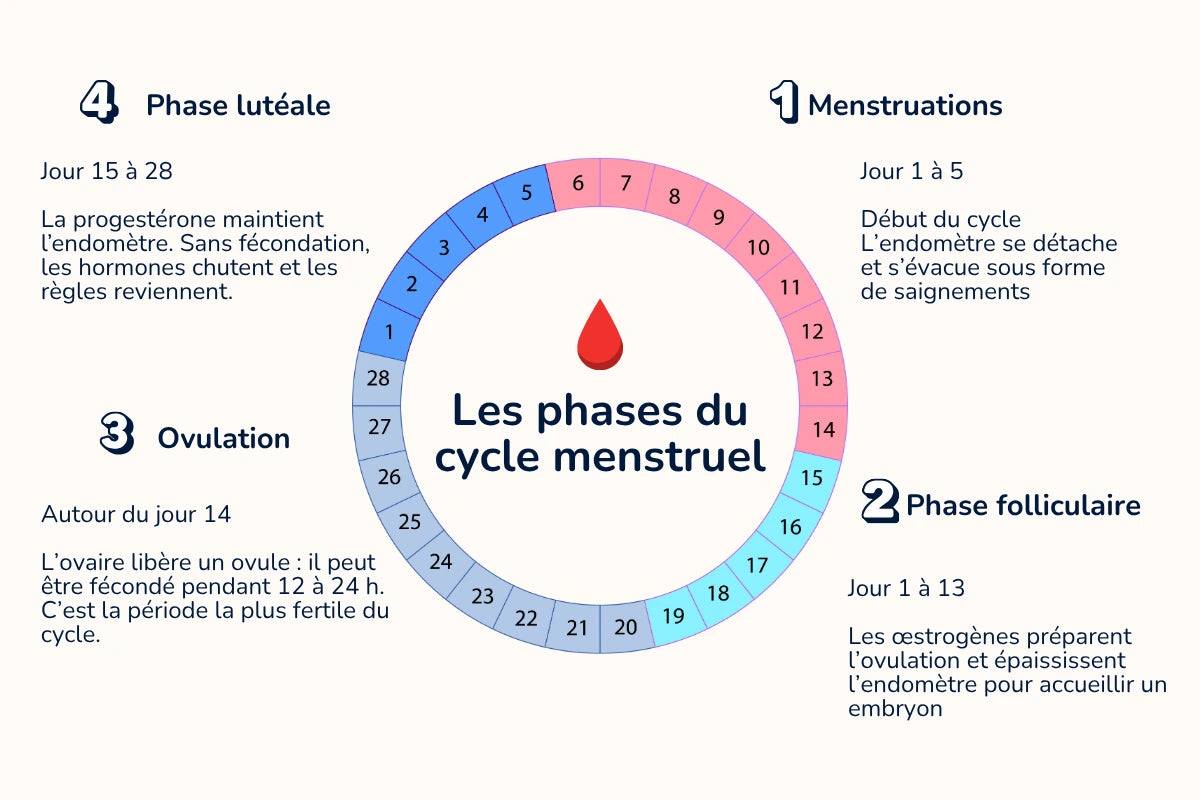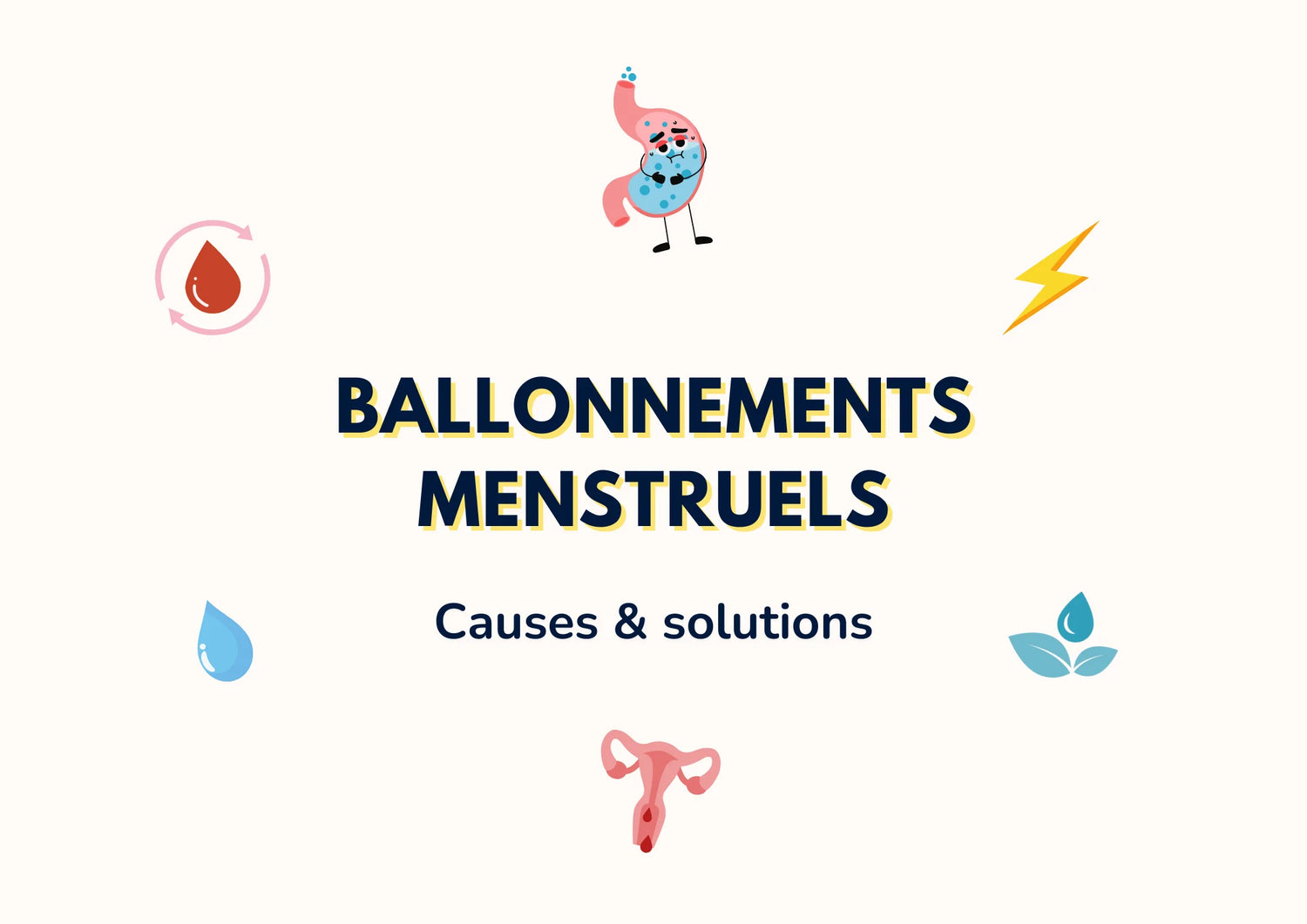You take the pill and yet, you have bleeding. Not very logical, is it? 🤔
Rest assured: it all depends on the type of pill what you take. Some cause bleeding planned (called withdrawal bleeding), others not. But sometimes, bleeding occurs outside these periods, and then doubt sets in.
No panic. These bleeding, although unsettling, are common and most often harmless. It is still important to understand them well in order not to worry unnecessarily.
Spotting, missed pill, dosage… We explain everything step by step to help you make sense of it all. 🧘♀️
Summary
What is the impact of the pill on the menstrual cycle?
You think you still have your period while on the pill, but in reality, they are not. Many women do not know that The pill prevents ovulation and stops the cycle, therefore the period.
This confusion creates false expectations and unnecessary worries with every bleeding. Here is what really happens in your body when you take the pill.
The pill contains synthetic hormones that mimic a state of pregnancye. Said like that, it may seem strange, yet it is what makes this method effective in preventing pregnancy!
But how exactly does it work?
We will detail the 3 main impacts of the pill on your menstrual cycle:
- It blocks ovulation
- It prevents the thickening of the endometrium
- She alters the cervical mucus
Here we go, we explain to you step by step how the pill works on your body and why these mechanisms prevent pregnancy!
1. It blocks ovulation
In a natural cycle, the brain sends signals (via hormones) to trigger ovulation, that is, the release of an egg from one of the ovaries.
But with the pill, it's a bit like the brain is "tricked": the synthetic hormonese (estrogens and/or progestogens) make him believe that a pregnancy is already underway.
Result: The brain no longer gives the order to release an egg.
No ovulation = no possible pregnancy. ✅
Good to know: some pills (progestin-only, like Microval) may not consistently block ovulation, but they work in other ways to prevent fertilization.
2. It prevents the thickening of the endometrium
The endometrium is the mucous membrane that lines your uterus. In a natural cycle, it thickens to accommodate a potential embryo. It's him that you evacuate when you have your period. 🩸
On the pill, the endometrium remains thin and decreases.
Why? Because the hormones are not the same as those in your body. They are dosed to prevent a proper preparation of the uterine "nest".
Result: even if by miracle an egg is fertilized, he would have nowhere to hold on to. It is an additional protection against pregnancy.
3. It alters the cervical mucus (secretion from the glands of the cervix)
Under normal circumstances, around ovulation, cervical mucus becomes fluid and elastic: it helps sperm swim up to the egg.
Under the pill, this mucus remains thick and sticky. Like a natural barrier, it makes the passage of sperm very difficult, if not impossible.
It's a bit like putting a cork in front of the door!
Reminder: How do rules work without contraception?
To talk about "periods" on the pill, you must first know how natural rules work.
To not confuse menstruation with artificial bleeding, to avoid being misled, worrying unnecessarily, or believing that your contraception is not working.
Let's go back to the basics together to better understand the difference!
The natural menstrual cycle consists of 4 phases, which follow one another to form a complete cycle. Their duration and intensity can vary from one woman to another:

2. The follicular phase: Under the effect of estrogens, an egg prepares and the endometrium begins to rebuild.
3. Ovulation : around the 14th day, the egg is released and can be fertilized for 12 to 24 hours. This is the most fertile phase.
4. The luteal phase : progesterone maintains the endometrium. In the absence of fertilization, hormone levels drop and menstruation and PMS return.
The natural ruless are therefore nothing other than the evacuation of a "nest" (the endometrium) prepared for a pregnancy that did not occur. But then, what does taking the pill do to our menstruation ? 🤔
Period while on the pill: what is it?
When you take a classic pill (type 21 active tablets + 7 days of break or placebos), you voluntarily enter into a hormone deprivation phase. During these 7 days without active hormones, the progesterone level drops. 📉
This hormonal drop triggers what is called a withdrawal hemorrhage : these are not no real rules, but a mechanical reaction of the uterus Upon stopping hormones. The endometrium, even if it is thin, detaches slightly, hence the bleeding.
These bleedings are artificial and not related to ovulation. Their presence is not a sign that "everything is working well," contrary to what has long been believed!
But where does this week of break come from then?
The the first pills were designed in the 1960s. At the time, doctors wanted women to continue having “periods” so as not to disrupt social and religious norms too much and also to reassure them: no bleeding = suspicion of pregnancy.
But today, we know that it is perfectly possible to take the pill continuously, without a break, and not to have any bleeding at all. It is safe if the contraception suits you and you are well monitored by a healthcare professional. 🤗
Now that you know how does the pill work and why these bleeding is not real periods, another question might be running through your mind: "But then, why do I still have bleeding outside of the break?"
Breakthrough bleeding on the pill: what are the causes?
You have some blood loss while you follow your pill to the letter. These bleedings catch you off guard, worry you, make you doubt your contraception. There are several reasons, often benign, for these bleedings. 🩸
Withdrawal hemorrhage
When you take a pill with a 7-day break (or placebo tablets), a hormonal drop occurs at the end of each cycle. This sudden change causes a artificial bleeding.
This is the famous "return of the period" that you know well. This process is completely normal.
Spotting
These are light bleeding outside the break weeke, often brownish or very light. This is a sign that your body is reacting to the hormones contained in the pill. Spotting is common among new users, but also among those who take a pill continuously.
You want to know everything about spotting: Spotting: what is it really about?
Your body is still adapting
During the 3 to 6 first months of a new pill (or a change in hormonal contraception), of the bleeding can appear in a unpredictable.
It's normal: your the body needs time to adjust to these new doses of hormones. This phenomenon is common and often resolves on its own. ⏳
A pill that is too strongly dosed
If your pill contains low estrogen, the endometrium may be too fragile, which makes it unstable.
Result: it can be partially detach, which causes the bleeding. This does not affect contraceptive effectiveness, but it can be uncomfortable. In this case, talk to your doctor: a dosage adjustment may be enough!
A missed pill
One missed pill, even just a few hours, can cause a sudden drop in hormone levels. This fall can trigger a bleeding, sometimes within 24 to 48 hours. Always remember to check the time of intake carefully. 🕰️
And in case over 12 hours of forgetting (or vomiting/diarrhea), remember: the risk of pregnancy increases. It is recommended to'use additional protection (condom) during the following 7 days.
Continuous capture
If you chain the pads without pausing, your endometrium sometimes ends up "cracking" : it becomes unstable and partially detaches. It's not serious, but it can become annoying over time. A simple solution: take a break from 4 to 7 days before resuming the pill (with your doctor's approval). 😊
Other possible causes to watch for
Even if the majority of bleedings under the pill are benign, some may reveal other factors:
An infection (chlamydia, mycoplasmas…) 🦠
The sexually transmitted infections (IST) can cause slight bleeding, often accompanied by abnormal discharge or pain. Chlamydia, in particular, is common among young women and can remain silent. A simple screening is enough to identify it.
An irritation or a micro-trauma after intercourse 💢
If the lubrication is insufficient, or if the report is a little more intense than usual, of small vaginal lesions may appear. They bleed slightly, but it heals within a few hours.
A fibroid or a uterine polyp 🌱
These minor benign anomalies can make the endometrium more fragile.
Result: bleeding outside of periods, sometimes heavier. A simple gynecological exam (such as an ultrasound) can detect them.
Stress, travel, digestive disorders 🧳
Jet lag, fatigue, diarrhea, vomiting… These situations can disrupt the proper absorption of the pill or the hormonal cycle.
Result: spotting or occasional bleeding. Again, this is common and the body quickly returns to balance. 🧘♀️
These losses are generally light, painless, brownish in color. If they become frequent, abundant or painful, consult your doctor. Let's talk specifically about those cases where it is important to consult.

Bleeding while on the pill: when to see a doctor?
You don't know if your bleeding is normal or if it should alert you. You imagine stressful scenarios: pregnancy? STI? illness? It's hard to make sense of it all, especially with online forums and conflicting information.
Here are the signals that warrant a medical consultation:
- Continuous bleeding over several cycles 🩸
- Severe pelvic pain 😣
- Fever or discomfort🤒
- Heavy and bright red bleeding 🩸🩸
- No withdrawal bleeding with combined pill (in case of missed pill or diarrhea) ❌
These cases require a pregnancy test, a screening or a change of contraception.
The right reflex? Consult your doctor, gynecologist, or midwife from the first signs. Fortunately, there are also simple solutions to manage bleeding when it is mild.
What to do in case of bleeding while on the pill?
These bleedings bother you, stress you, disturb you. You watch for the slightest trace, adjust your outfits, and end up living your days under tension. It’s heavy mentally and physically.
Here are some simple tips to take back control:
Use discreet and comfortable protection
To no longer be surprised, always keep a menstrual panty, a panty liner with you, or even a towel fine. Menstrual panties are particularly practical: absorbent, reusable, comfortable, and above all, they prevent the stress of stains in public.
Keep track: note the days of losses
You can note in a notebook, an app, or simply in your planner:
- The days when you have losses
- Their color (red, brown?).
- Their intensity
- If you have forgotten a tablet
There are applications like Clue or Flo to help you spot any potential pattern. This will also be very useful for your doctor in case of a consultation. 👍
Continuous pill use: take a break
The spotting is often the alert signal that the endometrium needs to shed a little.
You can then:
- Temporarily stop the pill for a few days (always with medical approval)
- Let the body "cleanse" the endometrium
- Then take a new brochure
This pause is safe in most cases, and it often helps stop minor bleeding.
Check if the losses persist for more than 3 months
Beyond 3 bleeding cycles, we need to ask ourselves questions. Maybe:
- Your pill is not properly dosed for your body
- An infection or irritation is in progress
- Your capture mode (continuous or not) does not suit you
A midwife or a doctor can reassure you, examine you if necessary, and offer you suitable solutions.
Adjust the dosage or change the contraceptive method
There is several types of pills:
- Combined (estrogen + progestin
- Progestative only
- Various dosages depending on the brands
If the one you are taking doesn't suit you (side effects, frequent spotting…), it is perfectly possible to change it. There is no shame in saying: "this one doesn't work for me." 🤗
Please read the instructions for your pill carefully
The notice can give you some valuable information :
- What to do in case of forgetfulness?
- What to do if you vomit after taking a tablet?
- Which medications interfere with the pill? (some antibiotics, for example)
Take a few minutes to read it, it's a good foundation to understand your body and avoid mistakes.
And above all, don't feel guilty! You are doing your best. You are taking your pill, you seek information, you try to understand what is happening in your body. These bleeding are simply a sign that your body is reacting. And sometimes, a little adjustment is needed to regain balance. 🤗
Having some bleeding while on the pill can surprise or worry. But you have seen: these losses often have a simple explanation and benign.
Whether it is a withdrawal bleeding, spotting, or a missed dose, it is not necessarily a sign of danger. The essential thing is to know listen to your body, to inform you and to consult if something seems abnormal to you.
Take care of yourself. 💙





 https://mysorio.com
https://mysorio.com


